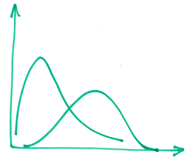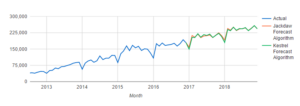Our panel of experts explain how you can make your forecasting even more accurate.
1. Educate other areas of the business about the impact of the ‘unknown’
Take out the frustrations generated by unplanned actions by addressing the areas of the business responsible for them.
Engage with those areas and educate them on the impact of the ‘unknown’ and work together to make it ‘known’.
My annual resource plan is built and regularly reviewed with full input from Marketing and Propositions Teams.
With thanks to Steve
2. Automate your forecasting models to free up time for analysis
Automating your forecasting models can free up time and allow for more work around analysis and accuracy.
With thanks to Alex
3. Don’t keep tampering with something that is working
If you create your forecasts manually and on a regular basis, stop updating them if you have managed to create a forecast that is close to what actually happens.
Then only update when it starts to vary again.
With thanks to Kay Leigh
4. Make it easy for your staff to flag up any changing trends
You should make it easy for your staff to flag up any noticeable trends, especially if they see any big changes in the type of calls/enquiries they are dealing with.
With thanks to Andy
5.The IT team should communicate system changes to the forecasting team
Ensure the IT team communicates any system changes to the forecasting team. Experience has shown that system changes frequently cause AHT impacts, especially at the start of the shift.
If it occurs immediately following a weekend or holiday where volumes are usually higher, advance knowledge will allow for planning.
With thanks to Mike
For more tips on improving communication across the contact centre, read our article: How to Improve Internal Communication in the Contact Centre
6. Track reasons for calls to help you understand the root cause
Track reasons for calls to help you understand the root cause of customer demand. This will allow you to better understand your call patterns and trends.
It will also enable you to understand the aberrations in your forecasting data, and it provides an opportunity for improvement activity.
With thanks to Owen
7. Remember not all months have the same number of days
Remember that not all months have the same number of days year on year.
This could make a difference if weekend volumes are out of sync with the rest of the week, so make sure you compare like-for-like.
With thanks to Ian
8. Give operational managers the opportunity to input the forecast
During your planning and forecasting process, give operational managers the opportunity to input and understand the forecast.
This will increase ownership and have a positive impact on plan adherence.
With thanks to Andy
9. Calculate parameters to highlight data points

Rather than eye-balling ‘abnormal data’, try calculating minimum / maximum parameters or using standard deviation to highlight data points in a large table of data.
You can do this using Microsoft Excel.
With thanks to Emma
10. Ask your marketing team to keep you in the loop about planned promotions
It is a good idea to ask your marketing team and sales team to keep you in the loop about any planned promotion.
This should include complete details on communication and target base to help to make your forecast as accurate as possible.
With thanks to Riddhi
11. Measure the accuracy of your forecast by calculating Hit Rate
One way to measure the accuracy of your forecast is with Hit Rate.
Ask yourself “How many (or what % of) forecasting periods are on target or within an acceptable variation?”
With thanks to Ian
12. Check your data against the CUIKA acronym
Make sure the data you use for forecasting is checked against CUIKA:
- Collected
- Usable
- Integrity
- Knowledgeable
- Action
With thanks to Ralph
13. Have processes in place that identify possible threats far in advance
Make sure you have processes in place that identify possible threats far in advance.
Such processes should include: holding monthly reviews, talking to the operations team about upcoming special events, keeping a regular eye on staffing updates and creating opportunities for open discussion on possible threats.
With thanks to Goska
14. Ensure that marketing system and process changes are on the agenda
If you are an outsourcer, ensure that marketing system and process changes are on the Service Review agenda for the months ahead.
They won’t always think it will affect your workload.
With thanks to Heather
15. Organise and track your historical data
Organise and track your historical data.
Understanding past trends will help shape future events, whether it be bank holidays or marketing responses.
With thanks to James
16. Make sure to always review any manual adjustments you make
When adjusting forecasts manually, always go back and review what you have changed.
Ask yourself “Have I improved the forecasts or made them worse?”
With thanks to Stephen
17. Use experience and knowledge rather than set parameters
When normalising data, use experience and knowledge rather than set parameters.
With thanks to Leigh
18. Always be proactive in planning activities
Always be proactive in planning activities.
This could involve talking to the marketing departments before sitting down to plan the allocation of the call centre’s resources.
With thanks to Louise
For more tips on being more proactive across each area of WFM, read our article: 50 Expert Tips to Improve Contact Centre WFM
19. Forecasting activities should be done on a daily basis
Forecasting activities should be done on a daily basis, especially if you amend the forecast manually. Otherwise you will never succeed.
You need to have control over your forecast.
With thanks to Goska
20. Adjust your forecast based on when your new products are being launched
You should make a conscious effort to adjust your forecast based on when new products are being launched.
With thanks to Vinay

21. Poisson Distribution can help you measure accuracy
Using the Poisson Distribution – calculated by finding the square root of the average of the actuals – can help you measure the accuracy of your forecast.
In simple terms, it predicts the degree of spread around a known average rate of occurrence, and gives you an indication of how accurate your forecast should be.
With thanks to James
For more on the Poisson Distribution, read our article: How is Average Handling Time (AHT) Distributed? It is Not How you Think!
22. Making note of deviations will help you filter your forecasting data
You should hold monthly handshake meetings with representatives from marketing (and other departments) to discuss and sign off any upcoming planned events. Anything not discussed is then noted as a deviation.
When looking back on historical data, these notes are helpful for filtering days marked as ‘deviations’ out of the data you will use for future forecasting.
With thanks to Emil
23. Ensure open communication between forecasting and operations
Ensure there is frequent and open two-way communication between the forecasting and the operations team.
Encourage operations to do the same with their agents. This should allow all upcoming events to be factored into the forecast and staffing plan.
This can include upcoming shrinkage (long-term time off/possible terms) or items that may have a positive or negative impact on volume or Average Handling Time (AHT).
With thanks to Mike
24. Only change one thing at a time to monitor impact
When adjusting your forecasts, only change one thing at a time to effectively monitor the impact.
This is because multiple changes might cancel each other out and you won’t know if they worked.
With thanks to Emma
25. Remember to use your gut instinct with your forecast
Remember to use your gut instinct with your forecast.
All the maths in the world alone cannot produce a forecast.
With thanks to Lisa
Click here to download our Monthly Forecasting Excel Spreadsheet Template
For more on the topic of contact centre forecasting, read our articles:
- How to Forecast Demand in the Contact Centre
- The Latest Techniques for Call Centre Forecasting
- How to Forecast With Minimal Data
Author: Megan Jones
Published On: 7th May 2014 - Last modified: 6th Nov 2020
Read more about - Hints and Tips, Forecasting
















I fully agree with number 2 “Automate your forecasting models to free up time for analysis”. Use the extra time for all other items!
One way to automate your forecast is using forecastingsoftware.